Re-serging
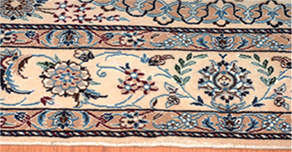
Just as tied-off fringe tassels hold the knots in place from the ends; the side cords hold the knots in place from the sides. The weft (left to right) threads are wrapped around a thick side cord that runs the entire length of the rug (with the warps). This cord holds the rows in place, and is usually (after the weaving is completed) wrapped in wool, cotton, goat hair, or silk. The over-wrapping is usually done in a color that blends well with the overall look of the rug.
Stain Removal
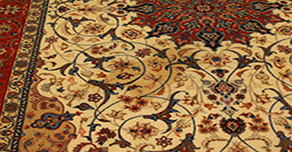
If tea, coffee, juice, alcohol, shoe polish or any greasy substance stains a carpet, the first step is to absorb it immediately with non-dyed cloth, blotting paper or tissue paper.Sponging with wool or silk and a compatible solution for removing the specific substance (tea, wine, and grease) should be done till the coloring substance has been wiped off. Each of the stains has different techniques for removing it. Many common substances are best removed rugs and carpet with following methods: a)Soft drinks, milk, coffee, tea, alcohol and chocolate can be removed by a mixture of lukewarm water and soap or non-alkaline detergents .b)Eggs and bloodstains can be removed with mixture of salt, on alkaline detergent and lukewarm water. c)Human and animal urine is best removed with white vinegar with lukewarm water. Clean grease, shoe polish and fatty substance with non-alkaline detergent and white vinegar.When fat spills on carpet, it should be first gathered with a spoon, then a piece of non-dyed cloth of white blotting paper should be over it and pressed slightly with hot iron. With this method the fat is absorbed
Side Repair
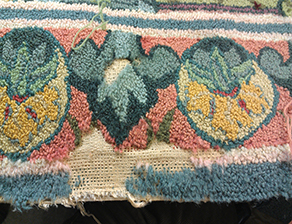
The side of rug also known as the selvage or the binding is what holds the rug together at the sides. As the rug is woven from side-to-side (across the warp strings - the non-exposed fringe) there must be an end point. This is end point is bound by the weaver both holding the shape of the rug and preventing knots to unravel. The binding can often become loose which encourages the rug to be damaged. Again it is best to deal with the problem as soon as possible as a small loosening of the selvage can soon become dramatic. The longer the problem is left the more damage is done and the more expensive it becomes to repair. The phrase a "stitch in time..." definitely applies when looking at hand-knotted rug repairs!
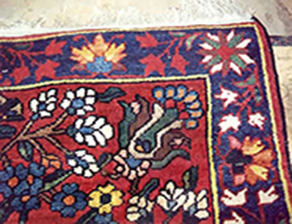
Carpet Repairs
Best done by professional, a few minor repairs may be attempted at home.If you have the skill, experience and patience, you may carry out minor repairs such as sewing the side cords, and the curling edges. The basic tools required are more or less the same as for weaving.Scissors, curved knives, metal combs, various sizes of hooks and needles, beeswax, pliers, a small wooden frame, natural fibre of cotton, wool and silk for piling and asset of magic makers.
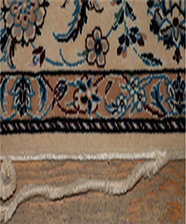
Binding
Some rugs (hooked rug) must be bound on the edges because the greatest point of wear on a rug is its edge. Carpet binding is used for any material being applied to the edge of a carpet. We do hand and machine binding.Leather /support binding.
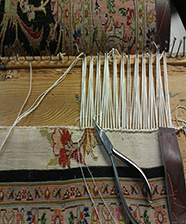
The Fringe (Click To Watch)
Most of the oriental rugs come with fringes. These fringes are basically added to go with the pattern and make the rugs look nice. However with the passage of time, usually fringe gets damage before anything else. The damage in the fringe evetually might end up slowly damaging your rug. The damage of a rug starts from a corner , if you repair the damage on time, you can save the rug. To fix or replace fringe for machine made rugs is quiet easy and inexpensive. for handmade rug, we weave a new yarn attaching with the rug . so that, it does not come out and perfectly match with the rug.
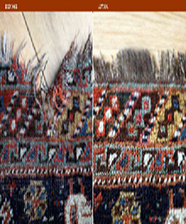
Repairing Kilim ends
After the fringes, the kilim ends are immediately woven to the rug, to prevent from fraying and to protect the rug, these weft threads have the same function as the fringes, If any thread in the kilim gets loose, these gradually break one by one effecting the knotted pile and the kilim gets ruined over a short time. In case the wrap and weft threads of this area get disintegrated or rotted, they should immediately be removed until the firm and solid weft threads are reached. Then with a strong and matching thread, normal, diagonal or zigzag snitches can be sewn along the wrap threads, by this method the decomposition of the rug is prevented.

Side Cords
This nice old Persian rug was in need of some repair. Side cords were all broken, fringes were gone and pile was coming off. It also had a three inches long cut on one side and there were also three spots where the pile was missing due to wear. Due to the value of the rug, it was more sensible to remove some of the pile from this rug to expose sound foundation threads to create new fringes. If it was a more valuable rug, a full restoration by anchoring in new foundation threads and re-piling the missing part of the rug would be more appropriate.
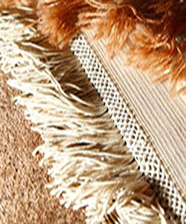
Wrinkles
In some of the rugs with the woollen wrap and weft some parts develop wrinkles , which means the foundation has rotted.There is no solution to get rid of these wrinkles.Its best to use these rugs in an area where there is less wear. If the wrinkled area is in the centre, the wrap and the weft can be pulled and stretched by inserting it into a wooden frame.
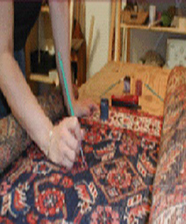
Dyeing
Selective dyeing is a cosmetic repair to make your rug look better.
Permanent textile dyes can be used to blend away worn areas, discolored areas, white knots, and repairs.
On collectable rugs dyeing beyond some small particular areas can affect the value of the rug. We will share the positives and negatives in these situations so you can make an informed decision.
